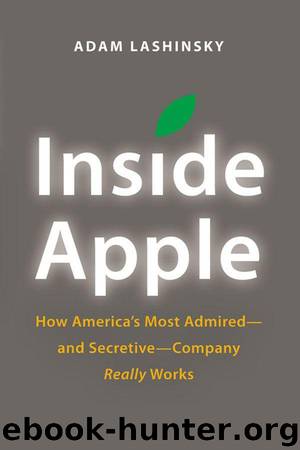Inside Apple: How America's Most Admired--and Secretive--Company Really Works by Adam Lashinsky

Author:Adam Lashinsky
Language: ru
Format: mobi, epub
Tags: Economics, Leadership, Management, Business & Economics, General
ISBN: 9781455512171
Publisher: Hachette Digital, Inc.
Published: 2012-01-25T05:00:00+00:00
As CEO, Steve Jobs developed a loyal and able corps of lieutenants, a group he continued to direct up until nearly the last days of his life, despite having given up the chief executive’s post. Jobs similarly dominated Apple’s board of directors, even though he was its chairman only after stepping down as CEO.
The tale of Arthur Levitt’s brief flirtation with joining the Apple board in 2001 illustrates how Jobs ran things. Levitt was nearing the end of his run as chairman of the Securities and Exchange Commission under Bill Clinton when Steve Jobs called to invite him to join the board. A committed Apple fan, Levitt was delighted. “I told him there’s no board in America I’d rather join,” Levitt recalled a decade later. Levitt flew to California, breakfasted with Jobs, met other members of the board, and attended Jobs’s Macworld keynote at San Francisco’s Moscone convention center. He received a board packet and a calendar of future board meetings and was excited about his first post-government assignment. Before he flew east, he left a copy of a recent speech he’d given on corporate governance with Fred Anderson, then Apple’s chief financial officer.
When Levitt landed, there was a message waiting for him from Jobs. “I called him back, and he said he didn’t think I’d be happy on the board,” Levitt said. “He was effectively saying I was no longer wanted.” Jobs didn’t seem to like Levitt’s opinion of what constituted good governance, including Levitt’s opinion that board members should attend all meetings. Larry Ellison, an Apple board member at the time and a close friend of Jobs, had a poor attendance record. “He said I wouldn’t be happy because his ‘best director’ didn’t attend board meetings,” said Levitt. “I was horribly disappointed.”
Jobs’s attitude toward Ellison, who left the board in 2002, citing his inability to attend board meetings, spoke volumes to his idea of board governance. Jobs continued to call Ellison his best director. He loved to tell the story of how he blew up the cover of a magazine with Ellison’s face on it and placed the life-sized photo in an empty chair at Apple board meetings. “I’d turn to him and say, ‘Larry, what do you think about that?’ ” Jobs recounted years later.
For years, Apple had no chairman, simply two “co-lead” directors, former Genentech CEO Art Levinson and former Intuit CEO Bill Campbell. The board had only six members other than the CEO, and many counted a connection to Jobs. Campbell was one of Jobs’s closest f Csardriends and personal advisers, and he eventually relinquished his “lead” role because of the fiduciary need to disclose facts of Jobs’s health he preferred not to discuss. Mickey Drexler had been CEO of the Gap, on whose board Jobs had served. Still, despite its personal connections to Jobs, Apple’s board was considered first-rate based on the quality of its members. Andrea Jung, CEO of Avon Products, brought consumer experience and took Campbell’s place as co-lead director. Al Gore,
Download
Inside Apple: How America's Most Admired--and Secretive--Company Really Works by Adam Lashinsky.epub
This site does not store any files on its server. We only index and link to content provided by other sites. Please contact the content providers to delete copyright contents if any and email us, we'll remove relevant links or contents immediately.
Hit Refresh by Satya Nadella(9038)
The Compound Effect by Darren Hardy(8808)
Change Your Questions, Change Your Life by Marilee Adams(7634)
Nudge - Improving Decisions about Health, Wealth, and Happiness by Thaler Sunstein(7615)
The Black Swan by Nassim Nicholas Taleb(7010)
Deep Work by Cal Newport(6878)
Daring Greatly by Brene Brown(6444)
Rich Dad Poor Dad by Robert T. Kiyosaki(6399)
Principles: Life and Work by Ray Dalio(6206)
Man-made Catastrophes and Risk Information Concealment by Dmitry Chernov & Didier Sornette(5921)
Playing to Win_ How Strategy Really Works by A.G. Lafley & Roger L. Martin(5915)
Digital Minimalism by Cal Newport;(5663)
Big Magic: Creative Living Beyond Fear by Elizabeth Gilbert(5610)
The Myth of the Strong Leader by Archie Brown(5424)
The Slight Edge by Jeff Olson(5346)
Discipline Equals Freedom by Jocko Willink(5284)
The Motivation Myth by Jeff Haden(5155)
Stone's Rules by Roger Stone(5026)
The Laws of Human Nature by Robert Greene(4996)
